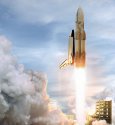China has developed a cutting-edge ultralight material for thermal insulation on its rockets and spacecraft, according to engineers.Zou Junfeng, a senior engineer at the Aerospace Institute of Advanced Materials and Processing Technology in Beijing, said the material, called aerogel, has been widely used in space missions by the United States, Russia and Europe.
"We have also developed our own aerogel products and some of them are at the highest technological level in the world," he said. "A lot of our spacecraft, satellites and rockets are now using our products to resist heat or maintain internal temperatures." The heavy-duty Long March 5 rocket, which will be China's most sophisticated and strongest launch vehicle, is scheduled to conduct its maiden flight before the end of this year.
It will use aerogel developed by Zou's institute to maintain the required temperature for its engine's pipes, he said."Our aerogel products are capable of not only insulating heat but also withstanding strong vibration, so they will ensure the smooth operation of the rocket," he said.
Moreover, the nation's future Mars rover will use aerogel to maintain warmth when it lands on the Red Planet."Our cargo spacecraft that will be launched next year will also be equipped with a refrigerator that uses our aerogel materials, significantly reducing the refrigerator's weight," Zou said. NASA also used aerogel for thermal insulation of its Mars Rover and space suits.
Zou's institute, part of the Third Academy of the China Aerospace Science and Industry Corp, specializes in materials used on spacecraft and missiles. It has developed a series of aerogel products that can work in a wide range of temperatures, from minus 100 C to 2,500 C. They are used in the Chinese military's latest weapons, said Cao Hui, director of the institute.
He said aerogel is the lightest solid material ever developed by humans, calling it a "magic material that will change the world".Cao said the institute's aerogel products are also used on China's large ships and high-speed trains, adding that engineers will promote the advanced material to more civilian sectors.











